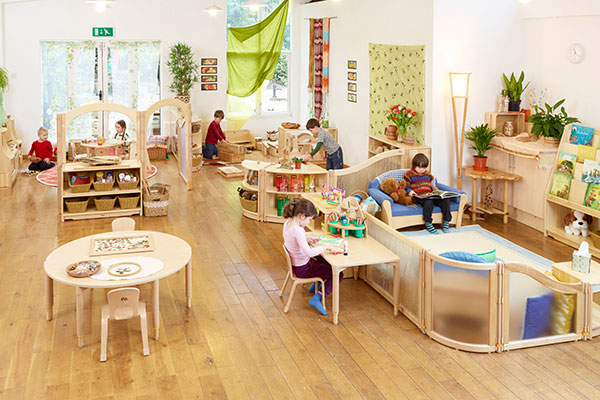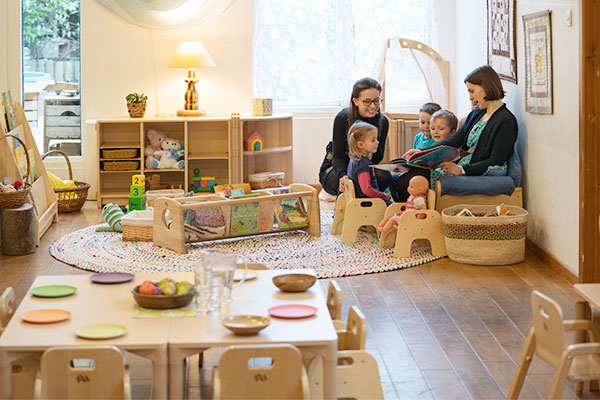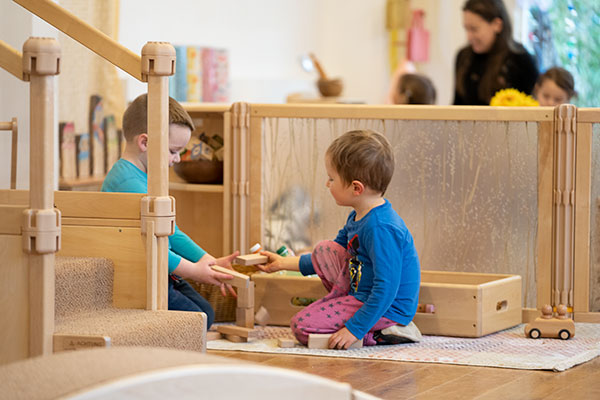The power of purposeful pre-school environments
| November 2019When you walk into a well-designed preschool classroom, you see children and adults working together in a productive surrounding. There are children constructively engaged and teachers busy observing, facilitating, and challenging the children. The environment supports all this by assuming several of the responsibilities we typically associate with teachers. It helps the children interact, learn, and avoid unproductive activities, such as running and getting in each other’s way. Thus, the environment actually becomes another teacher in the classroom.

Creating an environment to increase learning
Four major elements to consider when creating such an environment are:
- The well-being of those in the classroom (safety)
- The perspectives of those who will use the environment (culture)
- How the space accommodates appropriate activities (zoning)
- How the materials present should encourage learning (set-up)
Careful attention to these elements reduces how much time the teachers spend maintaining safety and order. This frees up time for higher levels of teaching, which ultimately increases learning.
Safety
Ensuring the well-being of those in the classroom
Just as a teacher’s most important role is ensuring the safety of her students, this is also the most important role of the environment. The better the environment is set up the less time the teacher needs to devote to this critical mission. For example, the environment needs to clearly specify the number of children permitted in each area, indicated for the children through signs or props. Just think of all the extra time a teacher might save from having to “direct traffic” every day if the environment assisted in this responsibility! The furniture should be stable, well-designed, and securely attached to the wall where necessary. Disorder in the environment can result in chaos, materials or furniture falling, dangerous cuts or splinters from sharp furniture edges, or other avoidable accidents.

Culture
Considering the perspectives of children
In order to make the people in the classroom as comfortable as possible, it is important that the environment considers the perspectives of those who will be using it. Look at the environment from a child’s level to check out what is functional and pleasing from that perspective. Since children are spending more hours in the school environment and less time at home, cosy and home-like touches in the environment increases the comfort of the child (e.g., pillows, baskets, curtains, and cushions). Uncomfortable children tend to be unproductive. Both adults and children function better in a thoughtfully designed space.
Zoning
Designing spaces that encourage appropriate activities
It is important that small group activities can happen naturally in the classroom environment (e.g., centre time where children may go to the art area or build with blocks). A well set up classroom environment facilitates a variety of group sizes and configurations: small group time, large group time, individual time, one-on-one with a teacher, and time to work with a partner.
Centre time
Think of the classroom areas such as block area or art area. These areas are typically set up for four children. The centres need to be clearly defined otherwise the teacher will need to spend much time organising, explaining, and “putting out fires.” Organising the areas by grouping the messy areas near each other and quiet areas near each other tends to work well. One major key in developing the centres is the organisation of space. Will the traffic of children flow easily? When planning, you want to avoid narrow spaces that restrict movement around the room and lead to something or someone getting bumped, or a child inadvertently entering another area. Also, avoid areas that have so much space that they say: “please run.”
Large group time
Large group time requires a space where the class may meet as a whole. If you have to move everything to get to this space daily, the time this takes will probably lead to frustrated adults and restless children. How will you set up seating? Comfort is essential for successful group time. Avoid tempting items that call out to children to fidget. Go to a restaurant and notice where you naturally sit. People tend to face the entry way. The more of the classroom the children can view, the more in control they feel.
Individual time
The Reggio Emilia Approach adds a group size often missed – a space to be alone. Children spend large amounts of time in classroom settings. Sometimes individuals need a time to regroup or relax by themselves. This area needs to feel private yet be easily observed by the teacher.
Set-up
Selecting materials that encourage learning
Areas should be set up to accommodate, facilitate, and challenge the children’s thinking. In this way, they can act as extensions of the teacher, who can’t be everywhere in the classroom at once. Ideally, the curriculum is set up so there is a cycle of familiar and novel experiences, building upon each other. The teacher sets up materials that are mostly familiar to the children. The children explore the materials to gain understanding. The teacher observes children using the materials. When the children have gained understanding of what is set up in the area, the teacher helps the children extend their learning and challenges them by adding or replacing a part of the familiar materials that are set up. Also, there should be enough materials, but not too many materials, as you want to encourage negotiation and sharing.
Think carefully about what pictures, children’s work, or photos you decide to place on the walls since children can absorb a lot from their surroundings. Instead of simply decorating the walls, teachers should use the space for good displays and documentation that encourage learning.
It takes a teacher a lot of time to trace and copy decorations for the classroom. It also takes time and money to buy commercial art to place on the walls, for example, cut-outs of Halloween witches or cute shamrocks. I am not sure, however, what these actually teach the children. When displaying pictures and photos, I look for beauty and relevance. Is the display aesthetically pleasing? Is it part of the children’s world, giving an opportunity to the child to make connections? I once had a toddler study a photo of a hand under a faucet and then go over and to the faucet and repeat what he saw. This photo was relevant to the child’s world, unlike seasonal cut-outs. In this way, even a room’s walls contribute to the environment’s role as a teacher in the room.
Conclusion
A preschooler enters her environment competent and aware. She will respond positively if the four major elements have been attended to: (1) the room feels safe, (2) it feels like it is set up for her and is comfortable, (3) the areas clearly communicate and encourage the activities she may partake in (zoning), and (4) the materials invite her to play and also give her a bit of a challenge (set up).
Pretend to be a child, look at the environment from her perspective and think about what she sees. Brainstorm all the questions a child would think of. Some examples are:
Is this place safe? Do I have an idea how the materials work? Do I know what I should do in each area? Are the materials really for me to play with or are they just for show? Where do things go in each area? Is there a place for me to hang my coat? Where do I put a messy picture? Is there any place in this room to relax? Will I be able to talk with my friend sometimes?
Taking the time to attend to the safety, culture, zoning, and materials in the classroom room creates an environment that teaches. Thus, instead of spending time as maintenance workers in the classroom doing such jobs such as moving furniture, reminding children not to run, picking up items that the children didn’t know where to put away, being nervous about a safety issue, or trying to get children to stop yelling because they are bored; teachers have time to interact, observe, and challenge the children.
References
Rui Olds, A. (2000). Child Care Design Guide. McGraw-Hill.
Sussna, A. G. (1995). The educational impact on preschool teachers of adaptation of the Reggio Emilia documentation process. Doctoral Dissertations Available from Proquest.








